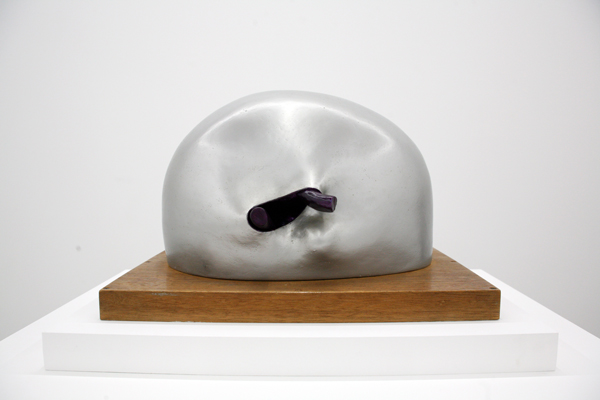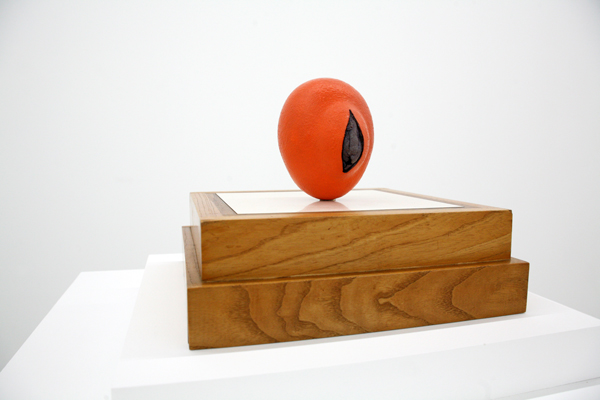Kenny Price’s objects are modest in size and endless in meaning, which is another way of saying they make you think and feel instead of just impressing you. At a recent career survey at Parrasch Heijnen Gallery’s inaugural LA show, the first piece you are confronted with is a hard pod-like object with an unnaturally vibrant orange surface, titled Orange (1964). On closer inspection there appears to be a struggling wooden-like object within the object, either trying to escape or in the process of being swallowed up. The first thing I felt was that a fake machine world was demolishing the natural world. Suddenly the wood-like object becomes human and the oceans fill with plastic and this tiny little sculpture fills me with dread and sorrow because I can’t save a small piece of wood.

Ken Price, Silver, 1961, acrylic and lacquer on fired ceramic with artist’s wood base, 12 x 13.5 x 18″, courtesy Parrasch Heijnen Gallery.
We have all heard the saying “less is more.” Obviously this does not apply to money or power, but in poetry an entire idea hides in a few words and in art one image can engulf the viewer. For me, small is somehow more fascinating than big. Big is merely impressive and when the idea does not deserve the space, you begin to ignore it for your own protection, which is what I do when faced with a gigantic balloon dog. Small, however—and I do not mean miniatures—demands that you climb down to its level.
So here we are at the next level. The adjacent sculpture, titled Silver (1961), looks like a lady’s handbag of polished steel and inside are strong steel bars from some prison, all curled up and forcing their way out. Of course, I think of my doctor father’s medical bag with all its instruments of death or the purse that my mother was forced to carry, which her virginity was constantly falling out of because that was her job way back in the ’50s.
Don’t get me wrong, you might not feel these things but mysteriously you will feel something, because these objects have something to say if you listen. These small sculptures are made with such care and such passionate intent that you cannot help but let your imagination fly away before your brain can hit the delete button.
There are other pieces like the tiny epic landscapes that you could fit in your hand. You wonder how something so small can seem so big and then you realize that your imagination is turning them into the land of another planet— not Earth, but the inside of your head.
I still remember the first Price I saw—a painting of a small cup on a table. I still wonder, who left it there? What used to be in it and why did I care? Was it about loss, leaving and loneliness? Will an excavator dig up this cup one day and remember me? Thank you Mr. Price.


